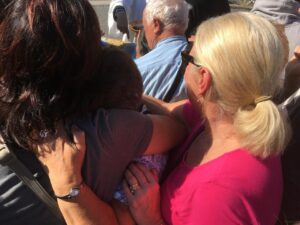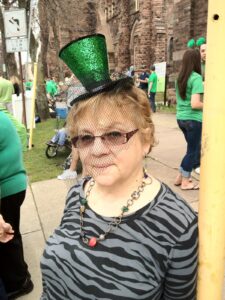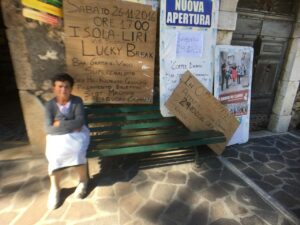Theme Table of Contents
VJIC Table of Contents
| A map is not the territory, it is only an abstraction or representation of it. |
This is the 5th essay in the theme inquiring into Street Photography. The first four essays in this theme worked to define the territory or paradigm of street photography, offering a map of sorts for considering the behavior of photographers.

© Michael Amrose
A word of caution is in order here. A map is not the territory, it is only an abstraction or representation of it. My purposes has been to unpack, or at least bring to your attention the narratives which steer practice and expectations of photographers and viewers (I refer to them as readers of the text, for photography as a social practice produces an image, a visual text, coded with intentions and meanings.).
Picking up a camera and taking photos on the street may be understood as street photography but as I have suggested it is more complicated and richer than that. What comes into play, thus steering practice, are the beliefs, assumptions and purposes embedded in the historical and cultural foundations of the person holding the camera and walking the streets. Even the idea of walking the streets is a behavior for reflection and analysis. Like all photography street photography is not different, it has purposes and intentions guided by social narratives determining the resulting image and the reading of it. As I have stated in earlier essays the meaning(s) of an image does not exist until we say it does. When we speak our voice reflects the social cultural and historical framework that steers our understandings and ability to communicate: the words we select.

© Michael Amrose
My discussion is not been about images in general but the process of their creation, the construction of meaning and its consumption by the photographer and the viewer. This process also includes post-street experience, the decisions made when a photographer (or someone else) edits and selects images to be seen, submitted or displayed.
I am noting that the photography experience includes the planning process or pre-shooting decisions, (deciding to photograph, what equipment to take and when to venture out) the hunt or the wait, post-editing and dissemination. Either conscious or unconscious decisions are made which will determine the final image.
What follows is an interview with Dennis Church on his work and life in what some have defined as street photography. Dennis talks about his relationship to the image and image making. He brings his own light to this conversation.
Interview Dennis Church
time 26:15
Recorded Spring 2025
Being nowhere
For me, photography is being there, in the moment, in the space. I believe that there are times when we are not conscious but engaged in nothingness. Let me explain.
Walking the streets, standing at the edge of a shadow or waiting by a puddle, one is conscious of being there. Walking the streets, looking, is an engaging activity while searching/hunting and waiting for the right moment. I should note that the “right moment” is always before you make the exposure, it is the moment of recognition, a moment of decision.

© Michael Amrose
I suggest that we do not listen to the voices (experts, teachers, reviewers and other photographers) telling us stories, made up truths of the past and how to look to the future. Let me explain what I mean by voices. We talk with and to ourselves, internal voices and dialogs, directing our actions, pointing us towards interesting places to stand and make “good” photographs. The voices emerge out of our past while pointing to a future. The past is composed of many voices directing our decisions, telling us what is “good” and what is “bad”. The voices tell us where to stand and points us to the “moment of decision”, the moment to “click”. The voices also tell us where and when to stand, your spot in a geography and the flow of time. The question to consider is what informs our voices?
Finding your spot or the stillness of mind is when the voices go silent and you are just in the moment. The silence of walking down the street, not seeing anything but seeing everything. Those periods of being there, of feeling over analysis, the silence over the noise and being are the moments guided, not by consciousness but being one with the moment. It is your time, your space, not defined by the voices of others, but by your own voice.

Youtube search result 13 July 2025
A few years back, maybe around 2005, I was introduced to notices and publications on something referred to as street photography. Photographing on the street was not new to my experiences of making images or to photography in general. Photographers since the early days of the medium photographed in limited and various ways on the street, limited by the technology they were able to employ and the possibilities they presented. As the technology evolved photographers became more mobile and fluid.
As time passed YouTube presented to me with a broad array of programs or channels that echoed a voice of authority, informing me about the practice, giving me tips to be successful and provided models of good behavior. That interested me on a few levels. First the definition and guidelines, second the activity itself and references to (however defined) successful practitioners, thirdly, the presentation of something called a “good photograph”. It is here through a broad range of dissemination, which included classes and workshops, exhibitions and publications that the construction of a practice was being further defined, the voices within.
My position in photography/image making, as well as other social and political activities, I consider and question any voice of authority including my own; in a sense a deconstructed voice, the narrative that guided my practice. I worked the streets as a photographer and as an observer. Walking the streets, making images, notations that spoke more about me and my relationship to image making and the world in general, more so than the spaces I pointed my lens towards. Recognizing that my notations were not objective recordings of interest but were subjective within a post-modernist and post-structuralist framework.
Photography like other activities, is not a neutral or natural act. I always worked in sequences and series to visually speak to some concern, topic or condition. I never just walked the streets making random images, hunting or waiting to make that one image.
Along the way I was introduced to the work of various photographers who were understood as noteworthy. I was not fully convinced as to their noteworthiness. (this reflection may be the result of working with images for 52 years, directing and curating exhibitions and publishing critical writings) I was interested in understanding what made them noteworthy, and in the end how I understood my own photographic work.
In doing so I found myself being interested in the average or unknown photographer because I believe that is where we find the essence of photography and not in the award and contest winners, published works or exhibitions at noted museums. Furthermore, I believe it is in the work of the unknown, the wandering spirit, the hopeful traveler that I believe speaks to street photography. We can also reflect on and inquire into the nature of platforms which engage snapshots, family albums, Facebook and Instagram, as forms that begin to frame the social acts and understandings that steer the behavior of image makers. I am not suggesting that we take away the recognition of the few but value the many, the unsung and invisible, to celebrate the image and image maker.
